#lms integration
Text
Salesforce World Tour NYC 2023 on December 14 — MapleLMS
MapleLMS is presenting at the Salesforce World Tour NYC 2023 on December 14, at Booth #108. Come join us for the session and discussion with our LMS experts!

Join MapleLMS at Salesforce World Tour NYC 2023 on December 14 @Booth 108
Discover the future of LMS integration with Salesforce and the Event software at the Salesforce World Tour NYC 2023 on December 14, with MapleLMS at Booth #108. The event details are as follows:
Day: Thursday, December 14, 2023
Venue: Javits Center, NYC, and Salesforce+
Timings: 9:00 a.m.–5:00 p.m. ET
Our LMS expert, Matt Peterson will be there to share the main KPIs in our exclusive session on “Unifying Data for Success: Top 10 Key Performance Indicators from Salesforce, Event Software, and LMS”!. He will also share insights on how to utilize data after integration with other systems to increase productivity by improved decision-making, customer engagement, and sales performance.
We are also distributing, a SPECIAL GIFT, a USDA-approved organic MAPLE SYRUP at the event. You can pre-book your Maple Syrup bottle by registering at the link below:
Booking Link:- https://zfrmz.com/QZiVvAIp7RWZt2GqiEIj
NOTE: “You can receive your FREE Maple Syrup from Booth #108 and carry it easily on the plane while traveling as both the bottle and its quantity are on the allowed list.”
MapleLMS has a decade-old experience in elevating the learning experience through useful insights of Salesforce LMS. If you would like to learn more about how we help organizations in their learning and training initiatives, please click the link below to book our LMS expert, Matt’s calendar:
We will be more than happy to welcome you at our booth during the Salesforce World Tour 2023 event. Please share this news with your colleagues or within your networks, who are attending World Tour NYC. Keep a close look on our social media channels for more updates until then. Hope to see you soon!
0 notes
Text

Acemero is a company that strives for excellence and is goal-oriented. We assist both businesses and individuals in developing mobile and web applications for their business.
Our Services include:
Web/UI/UX Design
CMS Development
E-Commerce Website
Mobile Apps
Digital Marketing
Branding
Domain & Hosting
API Integration
Our Products include :
Support Ticket System
Direct Selling Software
Learning Management System
Auditing Software
HYIP Software
E-Commerce Software
#Mobosoftware#software development#software developers#web development#cms web development services#cms website development company#cms#mlm software#hyip#ecommerce software#lms#audit software#API Integration#Branding#Digital Marketing#ui/ux design
2 notes
·
View notes
Text
Military Intelligence
Which topics would you like to be more informed about?
The spirit of KALAGA
Archeology
Forensics
Military Intelligence
Social integration
Accomplishing Social Integration
Because these are the things that comprise KALAGA.
Coming up with the first release of Gold Silvano
The birth of KALAGA.
Coming up on Amazon.
Military Intelligence
KALAGA is Coming soon
Soldier of Fortune ~Gold…
#dailyprompt#dailyprompt-2066#gold Sandalwood Knight#Gold Silvano#KALAGA LM JAYARAJ#KALAGA series#social integration
0 notes
Text
LDS Engineers is a leading Canvas LMS Development Company in Australia, offering expert solutions to clients across the globe, including India, the UK, the US, and more. Our team of experienced programmers is highly skilled in developing and managing Canvas LMS applications, ensuring that every project meets the unique needs of our clients.
At LDS Engineers, we prioritize customer satisfaction and provide a user-friendly environment, making it easy for organizations to enhance their learning management systems. Our team is dedicated to delivering high-quality Canvas LMS solutions that are cost-effective, flexible, and tailored to a wide range of industries. Whether you’re a small business or a large organization, we have the expertise to develop a system that fits your needs perfectly.
#canvas lms development#canvas lms development services#canvas lms integration development#canvas lms customization#canvas lms development company#canvas lms development in australia#custom canvas lms solutions#expert canvas lms developers#canvas lms software development#canvas lms api integration
0 notes
Text
LDS Engineers is a leading Canvas LMS development company in US, with a team of highly experienced programmers who specialize in this advanced learning management system. Our team is passionate about delivering top-quality Canvas LMS solutions, designed to meet all the unique requirements of our customers. We pride ourselves on creating user-friendly platforms that are intuitive and easy to navigate for users at all levels.

With a global presence, LDS Engineers provides Canvas LMS development services to clients in the US, India, Australia, and the UK. We are known for being cost-effective, flexible, and customer-focused, ensuring that our solutions cater to a wide range of industries. Our experience allows us to design, test, deliver, and manage your Canvas LMS applications with precision and efficiency.
#canvas lms development#canvas lms development services#canvas lms integration development#canvas lms development in us#canvas lms development company
0 notes
Text
more 🛌
#ok so living memory and s9 are obviously not the same. the people are obviously very very different#but i think the reason why none of it landed for me is because they feel too similar in ways i dont personally enjoy#the people of lm arent actually alive but. the people of s9#simply dont have any concept of the breadth of the human experience? to me anyway grief and loss are fundamental to existence#being wholly unaware of the complexities of life and living is kind of comparable to the fake existence of the lm holograms to me#because it's something so integral to the experience of . being alive#that it's hard to... idk#maybe this is the intent in which case neat + hope it gets expanded on in the patches#maybe the arcadion#but. anyway. i guess it's thought provoking#i also dont really know what to think of the mirroring of emet's philosophy in lm#because in this case it is literally true#but are we supposed to feel like it isnt?? bc of the parallels here?#these people are not people and are directly correlated to the suffering of MY people so it is morally fine to get rid of them#<- is this us or ascians#IRS JUST WEIRD. IT'S SO WEIRD. Are they cooking ❓❓ i guess we'll see
1 note
·
View note
Text
Launching a Microlearning Initiative: Strategies for Success

Launching a microlearning initiative for the first time can indeed be overwhelming. The promise of delivering concise, engaging, and effective training in short bursts is appealing, but the reality is that successful implementation requires careful planning and understanding. One of the main reasons microlearning initiatives fail is poor planning and implementation, often stemming from a lack of proper understanding of what microlearning can and cannot do. Additionally, many organizations approach microlearning with unrealistic expectations, hoping it will be a catch-all solution to their training problems. This guide aims to provide a comprehensive overview of how to successfully launch a microlearning initiative by addressing these challenges head-on.
Understanding Microlearning
What Microlearning Can Do
Enhance Knowledge Retention: By delivering content in small, manageable chunks, microlearning helps learners better retain information. Studies show that breaking information into bite-sized pieces makes it easier for the brain to process and store.
Increase Engagement: Short, focused modules are more engaging than lengthy training sessions. Learners are more likely to stay focused and complete the training when it doesn’t feel like a huge time commitment.
Facilitate Just-In-Time Learning: Microlearning is perfect for on-the-go learning. It allows employees to access the training they need exactly when they need it, leading to immediate application of skills and knowledge.
Support Continuous Learning: Microlearning encourages continuous learning and development by making it easy for employees to fit learning into their busy schedules.
What Microlearning Cannot Do
Replace Comprehensive Training Programs: Microlearning is not a substitute for in-depth training programs. While it’s excellent for reinforcing knowledge and providing quick updates, it cannot replace the depth of traditional training programs.
Solve All Training Problems: Microlearning is not a magic wand that can be used to address all training issues. It’s essential to identify the specific problems it can solve and not expect it to fix everything.
Cater to All Learning Styles: While microlearning is effective for many, it might not suit every learner’s style or preference. Some topics might require more extensive, interactive, or hands-on training methods.
Planning Your Microlearning Initiative
Identify Clear Objectives
Before launching a microlearning initiative, it’s crucial to define clear objectives. What do you want to achieve with microlearning? Objectives might include improving knowledge retention, increasing engagement, providing just-in-time training, or supporting continuous learning. Clear objectives will guide your planning and help you measure success.
Assess Training Needs
Conduct a thorough assessment of your training needs. Identify the specific skills and knowledge gaps that microlearning can address. Understand the pain points in your current training programs and determine if microlearning is the right solution. This assessment will help you design relevant and effective microlearning content.
Understand Your Audience
Knowing your audience is key to designing effective microlearning modules. Consider the following:
Learning Preferences: How do your employees prefer to learn? Do they like videos, interactive quizzes, or reading articles? Tailor your microlearning content to match their preferences.
Access to Technology: Ensure that your employees have access to the technology needed to engage with microlearning. This might include mobile devices, internet access, and the necessary software.
Time Constraints: Understand the time constraints of your employees. Design microlearning modules that can be completed within their available time.
Design Engaging Content
Content is the heart of any microlearning initiative. Here are some tips for designing engaging microlearning content:
Keep It Short and Focused: Each module should focus on a single topic or concept and be no longer than 5-10 minutes.
Use Multimedia: Incorporate videos, infographics, and interactive elements to make the content more engaging.
Include Assessments: Add quizzes or interactive activities to reinforce learning and provide immediate feedback.
Make It Relevant: Ensure that the content is directly relevant to the learners’ job roles and responsibilities.
Develop a Delivery Strategy
Decide how you will deliver your microlearning modules. Options include:
Learning Management Systems (LMS): An LMS can help you organize and track microlearning modules, making it easy for employees to access and complete them.
Mobile Apps: Mobile apps are perfect for delivering microlearning on the go. They allow employees to access training anytime, anywhere.
Email Campaigns: Email campaigns can be an effective way to deliver microlearning modules directly to employees’ inboxes.
Implement and Monitor
Once you’ve planned your microlearning initiative, it’s time to implement and monitor it. Here’s how:
Pilot Test: Start with a small group of employees to test the microlearning modules. Gather feedback and make necessary adjustments.
Launch: Roll out the microlearning initiative to the entire organization. Ensure that employees know how to access and use the modules.
Monitor Progress: Use analytics to track completion rates, engagement levels, and assessment scores. Monitor progress to identify any issues and make continuous improvements.
Common Pitfalls to Avoid
Unrealistic Expectations
One of the biggest mistakes organizations make is expecting microlearning to be a one-size-fits-all solution. It’s important to have realistic expectations and understand that microlearning is a tool that works best when used for specific purposes.
Lack of Integration
Microlearning should not exist in a vacuum. It should be integrated into your overall training and development strategy. Ensure that microlearning modules complement other training initiatives and provide a seamless learning experience.
Poor Quality Content
The effectiveness of microlearning hinges on the quality of the content. Avoid cramming too much information into a single module. Focus on delivering high-quality, concise, and relevant content that meets the learners’ needs.
Inadequate Support
Ensure that employees have the support they need to engage with microlearning. This includes technical support for accessing the modules and guidance on how to make the most of the training.
Measuring Success
To determine the success of your microlearning initiative, you need to measure its impact. Here are some key metrics to track:
Engagement Metrics
Completion Rates: Track the percentage of employees who complete the microlearning modules.
Time Spent: Measure the average time employees spend on each module to gauge engagement levels.
Learning Outcomes
Assessment Scores: Use quizzes and assessments to measure knowledge retention and understanding.
Application of Skills: Monitor how well employees apply the learned skills in their job roles.
Feedback
Employee Feedback: Gather feedback from employees to understand their experience with the microlearning modules and identify areas for improvement.
Manager Feedback: Get feedback from managers on the impact of microlearning on employee performance and behavior.
ROI
Cost Savings: Calculate the cost savings from reduced training time and resources.
Performance Improvement: Measure improvements in key performance indicators (KPIs) that are directly related to the training objectives.
Conclusion
Launching a successful microlearning initiative requires careful planning, understanding, and execution. By setting clear objectives, assessing training needs, designing engaging content, and continuously monitoring progress, you can ensure that your microlearning initiative delivers the desired results. Avoid common pitfalls such as unrealistic expectations, poor quality content, and lack of integration. Instead, focus on creating a seamless, engaging, and effective learning experience that meets the specific needs of your organization. With the right approach, microlearning can be a powerful tool for enhancing employee training and development, ultimately leading to improved performance and ROI.
#microlearning#learning objectives#Microlearning#Learning initiative#Training programs#Employee training#Learning objectives#Training effectiveness#Knowledge retention#Engagement#Just-in-time learning#Continuous learning#Training needs assessment#Audience analysis#Learning preferences#Mobile learning#Learning Management System (LMS)#Pilot testing#Implementation strategy#Monitoring progress#Unrealistic expectations#Training integration#Content quality#Technical support#Engagement metrics#Learning outcomes#ROI (Return on Investment)#Performance improvement#Learning analytics#Training feedback
0 notes
Text
WEBINAR
Unifying Data for Success: Top Key Performance Indicators from Salesforce & LMS
26 June 2024
2:00 PM ET
Register Now
#maplelms#lms for associations#salesforce lms#learning management system#online learning#onlinelearning#lms integration with salesforce
0 notes
Text
Enhancing Online Learning Platforms with Seamless LMS Integrations
Discover the transformative power of integrating Learning Management Systems (LMS) into online learning platforms! In our latest blog post on MagicBox, we explore six ways LMS integrations enrich the learning experience, from streamlining content delivery to fostering personalized learning journeys. Dive into the world of educational technology and unlock the joy of learning today!
Read the full article here.
0 notes
Text
Unlock Seamless Learning Experiences with Our LMS Integration Solutions

Are you looking to enhance your e-learning platform with seamless integration solutions? Look no further! At eLearning Garage Production, we specialize in providing LMS integration services that streamline your learning management system and empower you to deliver exceptional educational experiences.
What Sets Us Apart
Tailored Solutions: We understand that every organization has unique needs and requirements when it comes to LMS integration. That's why we offer tailored solutions designed to meet your specific objectives and challenges.
Expertise: With years of experience in the e-learning industry, our team of experts has the knowledge and skills to handle even the most complex integration projects.
Collaborative Approach: We believe in working closely with our clients every step of the way to ensure that our solutions align with their vision and goals.
Cutting-Edge Technology: We leverage the latest technology and tools to develop innovative integration solutions that enhance the functionality and performance of your LMS.
Our Services
Integration Consulting: We'll assess your existing learning management system and provide expert advice on how to optimize its performance through integration with other tools and platforms.
Custom Integration Development: Our team of developers will create custom integration solutions tailored to your specific requirements, ensuring seamless connectivity between your LMS and other systems.
Implementation and Support: We'll handle the entire implementation process, from planning and deployment to ongoing maintenance and support, so you can focus on delivering high-quality learning experiences to your users.
Why Choose Us
Dedication to Excellence: We're committed to delivering excellence in everything we do, from the quality of our solutions to the level of service we provide to our clients.
Customer-Centric Approach: Our customers are at the heart of everything we do, and we go above and beyond to ensure their satisfaction and success.
Innovation: We're always looking for ways to innovate and improve our solutions, so you can stay ahead of the curve and deliver cutting-edge learning experiences to your users.
Get Started Today
Ready to take your e-learning platform to the next level with our LMS integration solutions? Contact us today to learn more about how we can help you unlock seamless learning experiences for your users.
Feel free to adjust this content to match your company's voice and branding!
0 notes
Text
The Power of LMS eCommerce Integration for Your Online Learning Business
In today’s digital age, education and eCommerce are colliding in exciting ways, providing new opportunities for businesses to deliver training programs and courses effectively. Learning Management Systems (LMS) are pivotal for online education, offering a structured platform for course creation, management, and delivery. However, combining LMS with eCommerce capabilities takes your business to the next level. LMS eCommerce integration is a powerful strategy that allows educational institutions, corporate trainers, and independent course creators to monetize their content easily. This article explores the significance of LMS eCommerce integration, the benefits it offers, and why your organization should consider adopting it.

Why LMS eCommerce Integration is Essential
The integration of LMS and eCommerce allows businesses to streamline their educational offerings and generate revenue simultaneously. Here are the primary reasons why LMS eCommerce integration is crucial for businesses:
Monetization of Educational Content: The most significant advantage of LMS eCommerce integration is the ability to monetize your learning content. By combining an LMS with eCommerce platforms, you can sell your courses, learning materials, and certifications online, providing a seamless user experience from learning to purchasing.
Improved User Experience: Learners expect an intuitive, user-friendly experience when purchasing courses. An integrated LMS and eCommerce system eliminates the need for learners to navigate through multiple platforms to complete their purchase and begin their learning journey. With a seamless checkout process, automated course access, and instant payment confirmation, you enhance the user experience and reduce drop-off rates.
Automated Course Enrollment: LMS eCommerce integration allows for automated enrollment once a purchase is completed. This means that once a learner has paid for a course, they can immediately start learning without waiting for manual approval, thus speeding up the learning process and reducing administrative tasks.
Secure Transactions: eCommerce integrations provide robust, secure payment gateways that protect both your business and your learners. Ensuring that transactions are secure fosters trust and encourages repeat purchases. Integrated platforms can also offer various payment methods, including credit cards, PayPal, and more, ensuring a convenient purchasing process.
Key Features of LMS eCommerce Integration
When choosing to integrate an LMS with an eCommerce system, there are several key features to consider:
Course Bundling and Subscriptions: LMS eCommerce integration allows for flexibility in pricing models. You can offer course bundles, monthly subscriptions, or even tiered memberships, maximizing revenue potential and offering students a range of pricing options that cater to their needs.
Discount and Coupon Management: Marketing plays a significant role in online education, and offering discounts and coupons can help attract more learners. LMS eCommerce integration allows businesses to manage promotional offers directly within the platform, making it easier to create and distribute special deals to your target audience.
Tracking and Analytics: Combining LMS with eCommerce gives you access to comprehensive tracking and analytics. You can track sales data, course enrollment, completion rates, and customer feedback all in one place. This helps in fine-tuning your marketing strategies and course offerings.
Customizable Storefronts: With LMS eCommerce integration, you can customize your storefront to reflect your brand identity, making the platform more professional and trustworthy. This boosts credibility and helps in converting more leads into paying customers.
Why Choose edZ LMS for LMS eCommerce Integration?
At edZ LMS, we understand the unique challenges that businesses face when trying to integrate education and commerce. Our LMS eCommerce integration solutions are designed to make the process simple and effective, enabling you to focus on creating top-notch learning content while we handle the complexities of integrating secure payment systems, automated course delivery, and seamless user experiences.
Whether you’re looking to sell individual courses, create subscriptions, or offer bundled learning programs, edZ LMS has the right tools and expertise to make your LMS eCommerce integration a success. With features like customizable storefronts, advanced analytics, and secure payment gateways, we empower businesses to scale their educational offerings effectively.
Conclusion
Incorporating eCommerce into your LMS is no longer an option—it's a necessity for businesses that want to grow and succeed in the competitive online learning space. LMS eCommerce integration streamlines the learning process, enhances user experience, and opens up new revenue streams. At edZ LMS, we provide tailor-made solutions to help you seamlessly integrate eCommerce with your LMS.
Contact Us today to learn how we can support your business in leveraging LMS eCommerce integration to its fullest potential. Reach us at [email protected] or call us at +91 – 9916662080. You can also schedule a demo through this link or read our latest blogs for more insights.
0 notes
Link
LTI integration standards help ensure that these integrations are successful.
0 notes
Text
LDS Engineers is a leading Canvas LMS Development Company in Australia, offering expert solutions to clients across the globe, including India, the UK, the US, and more. Our team of experienced programmers is highly skilled in developing and managing Canvas LMS applications, ensuring that every project meets the unique needs of our clients.

At LDS Engineers, we prioritize customer satisfaction and provide a user-friendly environment, making it easy for organizations to enhance their learning management systems. Our team is dedicated to delivering high-quality Canvas LMS solutions that are cost-effective, flexible, and tailored to a wide range of industries. Whether you’re a small business or a large organization, we have the expertise to develop a system that fits your needs perfectly.
#canvas lms development#canvas lms development services#canvas lms integration development#canvas lms customization#canvas lms development company#canvas lms development in australia#custom canvas lms solutions#expert canvas lms developers#canvas lms software development#canvas lms api integration
0 notes
Text
The Benefits of Integrating MeetMonk LMS into Your Workflow

The importance of training and development programs in today's fast-paced business world cannot be overstated. With ever-changing technologies, market trends, and consumer preferences, it is essential for organisations to keep their employees up-to-date and well-informed. That's where Learning Management Systems (LMS) come in.
MeetMonk's LMS is a powerful learning management system designed to help modern organisations stay ahead of the game by simplifying and personalising the learning experience for their employees. Here are some of the key features of MeetMonk's LMS that make it a popular choice for organisations of all sizes:
Simplified Learning Experience: MeetMonk's LMS has a user-friendly interface that is easy to navigate and use. This means that learners can focus on the content and their progress, rather than getting lost in the platform's features.
Personalized Learning: MeetMonk's LMS offers a personalised learning experience that caters to the individual needs of each learner. This personalised approach allows learners to set their own pace, choose their learning path, and engage with content that is most relevant to their needs.
Comprehensive Content Library: MeetMonk's offers a comprehensive content library that includes videos, interactive quizzes, assessments, and other resources. This allows learners to access a range of learning materials and engage in a variety of learning activities. The content library is regularly updated to ensure that learners have access to the most up-to-date information and resources.
Real-Time Progress Tracking: MeetMonk's LMS offers real-time progress tracking, which allows teachers and administrators to monitor learners' progress and provide feedback as needed. This feature enables learners to track their own progress and see how they are improving over time.
Collaborative Learning: MeetMonk's LMS allows for collaboration between learners and teachers, as well as peer-to-peer collaboration. This promotes social learning, which can help learners to gain a deeper understanding of the subject matter. The platform also allows for communication and feedback, which fosters a supportive learning environment.
Mobile Accessibility: MeetMonk's LMS is mobile-friendly, which means learners can access the platform from any device, anywhere, and at any time. This flexibility enables learners to fit their learning around their busy schedules. Mobile accessibility also means that learners can access the platform on the go, making it an ideal solution for remote workers or those who work in the field.
Seamless Integration: MeetMonk's LMS is easy to integrate with other tools and platforms, such as Google Classroom and Zoom. This makes it a versatile platform that can be used in a variety of settings, including in-person and remote learning environments. Seamless integration with other platforms also means that learners and administrators can access all of their tools in one place.
MeetMonk's LMS is an innovative solution
MeetMonk’s LMS offers several benefits for modern organisations. Here, we will explore the benefits of integrating MeetMonk's LMS into your workflow.
Simplified Learning Experience
One of the primary benefits of using MeetMonk's LMS is the simplified learning experience it offers. The platform has a user-friendly interface that is easy to navigate and use, even for non-technical users. This simplification of the learning experience allows learners to focus on the content and their progress, rather than getting lost in the platform's features.
Personalised Learning
Every learner has unique needs and learning styles. MeetMonk's LMS offers a personalised learning experience that caters to the individual needs of each learner. This personalised approach allows learners to set their own pace, choose their learning path, and engage with content that is most relevant to their needs.
Comprehensive Content Library
MeetMonk's LMS offers a comprehensive content library that includes videos, interactive quizzes, assessments, and other resources. This allows learners to access a range of learning materials and engage in a variety of learning activities. The content library is regularly updated to ensure that learners have access to the most up-to-date information and resources.
Real-Time Progress Tracking
MeetMonk's LMS offers real-time progress tracking, which allows teachers and administrators to monitor learners' progress and provide feedback as needed. This feature enables learners to track their own progress and see how they are improving over time.
Collaborative Learning
MeetMonk's LMS allows for collaboration between learners and teachers, as well as peer-to-peer collaboration. This promotes social learning, which can help learners to gain a deeper understanding of the subject matter. The platform also allows for communication and feedback, which fosters a supportive learning environment.
Mobile Accessibility
MeetMonk's LMS is mobile-friendly, which means learners can access the platform from any device, anywhere, and at any time. This flexibility enables learners to fit their learning around their busy schedules. Mobile accessibility also means that learners can access the platform on the go, making it an ideal solution for remote workers or those who work in the field.
Seamless Integration
MeetMonk's LMS is easy to integrate with other tools and platforms, such as Google Classroom and Zoom. This makes it a versatile platform that can be used in a variety of settings, including in-person and remote learning environments. Seamless integration with other platforms also means that learners and administrators can access all of their tools in one place.
Customization and Branding
MeetMonk's LMS offers customization and branding options, which allows organisations to create a unique and professional learning environment. Customization options include the ability to add a logo, customise the colour scheme, and create a custom domain name. This branding ensures that the learning environment aligns with the organisation's values and brand image.
Cost-Effective
MeetMonk's LMS is a cost-effective solution for organisations of all sizes. The platform's pricing is transparent, with no hidden fees or long-term contracts. The pricing is based on the number of learners, making it an ideal solution for organisations with a small budget.
Improved ROI
MeetMonk's LMS Integrations into your workflow can improve your Return on Investment (ROI). This is because the platform provides a streamlined and efficient way to deliver training and development programs.
MeetMonk's LMS is a cost-effective solution for organisations of all sizes. The platform's pricing is transparent, with no hidden fees or long-term contracts. The pricing is based on the number of learners, making it an ideal solution for organisations with a small budget.
MeetMonk's LMS is an innovative and versatile solution that simplifies and personalities the learning experience for modern organisations. From personalised learning to mobile accessibility and real-time progress tracking, MeetMonk's LMS is a powerful tool that can help organisations to stay ahead of the game by providing their employees with the training and development they need to succeed.

0 notes
Text
IC TEMPERATURE SENSORS
Introduction
An Integrated Circuit (IC) temperature sensor is a semiconductor type temperature sensor which is in the shape of an IC unlike other temperature sensors (RTD, Thermocouple etc..). These sensors will produce an analog or digital output proportional to the temperature without additional circuits. Though these sensors are built in an IC, the size of these sensors will be very small and…

View On WordPress
0 notes
Text
Apollo Program: Lunar Module (LM) production and names
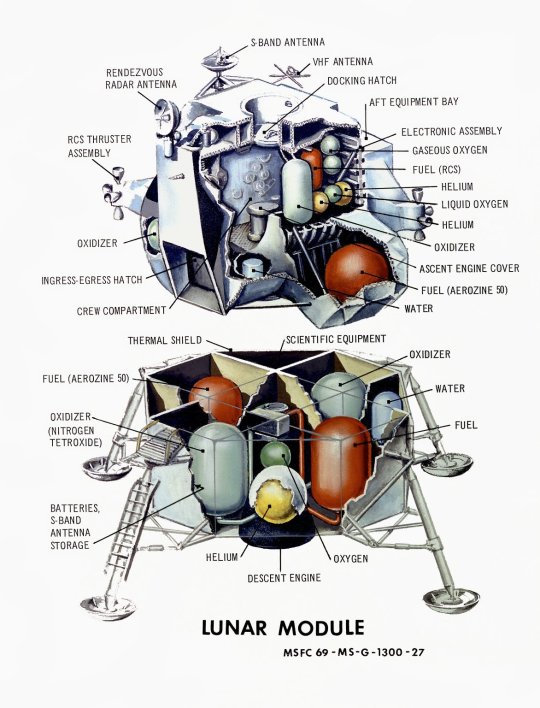
The Grumman Aerospace Corporation was awarded the contract on November 7, 1962. Originally designated Lunar Excursion Module (LEM), NASA ordered 25 lunar modules (10 test articles and 15 production models) for testing and landing on the moon. This was to go with the 15 Saturn Vs and Apollo CSMs. They were assembled in Grumman's factory in Bethpage, New York.
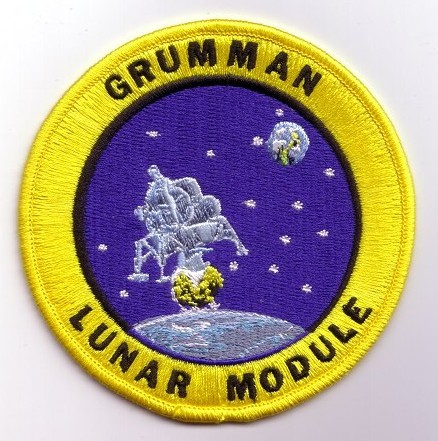

"There were initially four major subcontractors: Bell Aerosystems (ascent engine), Hamilton Standard (environmental control systems), Marquardt (reaction control system) and Rocketdyne (descent engine).
The Primary Guidance, Navigation and Control System (PGNCS) was developed by the MIT Instrumentation Laboratory; the Apollo Guidance Computer was manufactured by Raytheon (a similar guidance system was used in the command module). A backup navigation tool, the Abort Guidance System (AGS), was developed by TRW."
-Information from Wikipedia: link
After the Gemini 3 spacecraft was dubbed Molly Brown by Gus Grissom, NASA forbade naming spacecraft. For Apollo 9, this changed due to mission controllers in Houston needing a way to differentiate between the two spacecraft.
Between 1969 and 1972, Grumman produced a series of insignias for their Lunar Modules which were distributed in limited quantities to their employees in the form of decals and prints.

Apollo 5 (LM-1): none

Apollo 3 (and later 2) (LM-2): Never used, intended for a mission similar to Apollo 5. The success of LM-1 led to the cancellation.
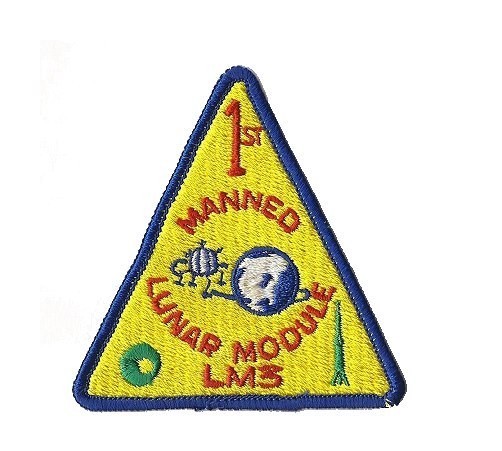

Apollo 9 (LM-3): Spider


Apollo 10 (LM-4): Snoopy. The LM ascent stage in heliocentric orbit and is the only known one to have survived intact
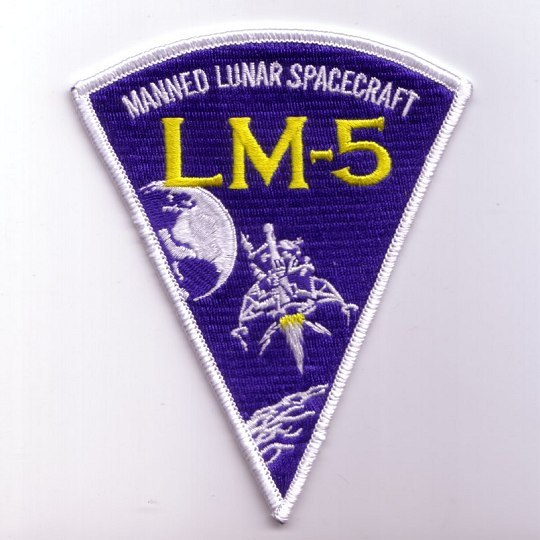

Apollo 11 (LM-5): Eagle (originally named haystack)


Apollo 12 (LM-6): Intrepid
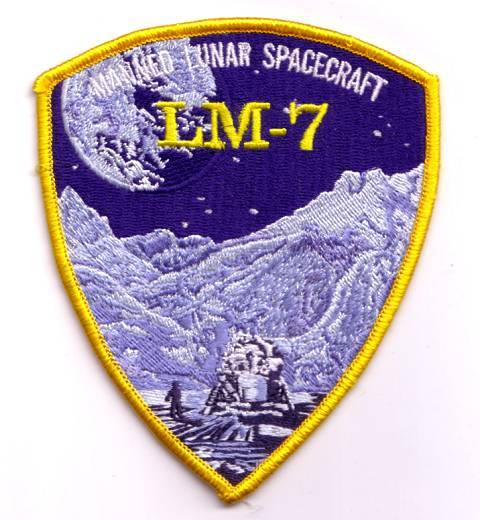

Apollo 13 (LM-7): Aquarius
Humorously, Grumman sent North American (the manufacturer of the Apollo Command and Service Module) a tow bill sometime after the crew returned. North American retorted back saying they've never sent them a tow bill for the previous missions.
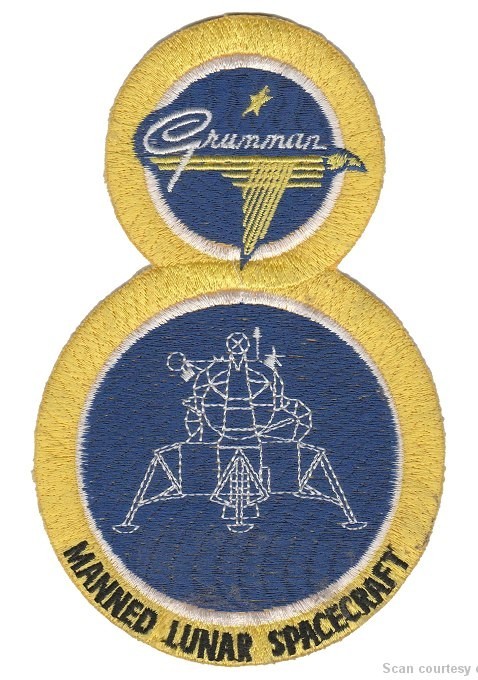

Apollo 14 (LM-8): Antares.


Apollo 15 (originally) (LM-9): never used, on display the Kennedy Space Center.
Intended for Apollo 15 and was the last H-type mission. When Apollo 18 was cancelled, it was decided to make Apollo 15 the first J-type mission.


Apollo 15 (LM-10): Falcon, originally intended for Apollo 16. First of the extended stay series.
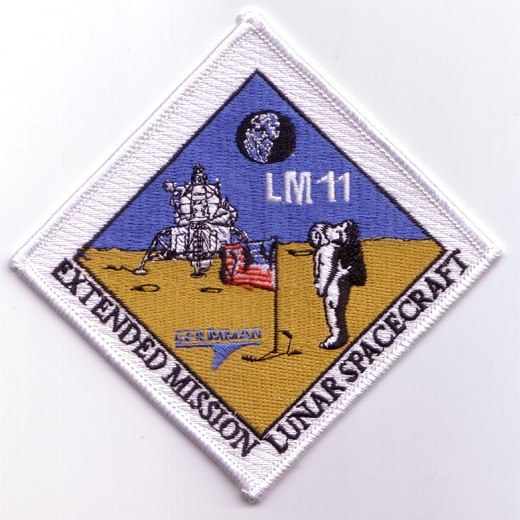

Apollo 16 (LM-11): Orion, originally intended for Apollo 17
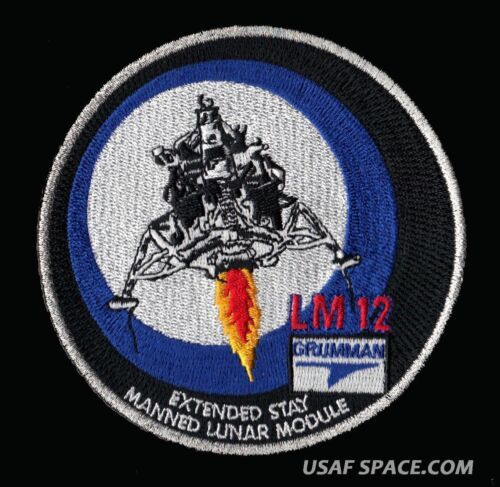

Apollo 17 (LM-12): Challenger, originally intended for Apollo 18.
Note: this name was reused for the second operational Space Shuttle Orbiter. After the Challenger Disaster, NASA officially retired the name.


Apollo 18 (LM-13): never used, originally intended for 19. It was partially completed when Apollo 18 and 19 were cancelled. Later restored by Grumman workers and is on display at the Cradle of Aviation History and Education Center.
Apollo 19 (LM-14): never used, originally intended for Apollo 20. It was partially completed when Apollo 18 and 19 were cancelled. What was completed, was later scrapped.

Apollo 20 (LM-15): never used, partially completed, scrapped. When Apollo 20 was cancelled, it was intended for modification into the Apollo Telescope Mount. Later the Telescope Mount was integrated into Skylab and this dedicated mission was cancelled.
source, source, source, source, source
NASA ID: MSFC-69-MS-G-1300-27, S67-50927, AS09-21-3183, AS10-34-5087, AS11-40-5946, AS12-46-6726, AS13-59-8566, AS14-66-9306, AS15-88-11866, AS16-113-18339, AS17-140-21370
#Lunar Module#Apollo Program#Apollo 5#LM-1#LM-2#Apollo 9#LM-3#Apollo 10#LM-4#Apollo 11#LM-5#Apollo 12#LM-6#Apollo 13#LM-7#Apollo 14#LM-8#LM-9#Apollo 15#LM-10#Apollo 16#LM-11#Apollo 17#LM-12#Apollo 18#LM-13#Apollo 19#LM-14#Apollo 20#LM-15
238 notes
·
View notes